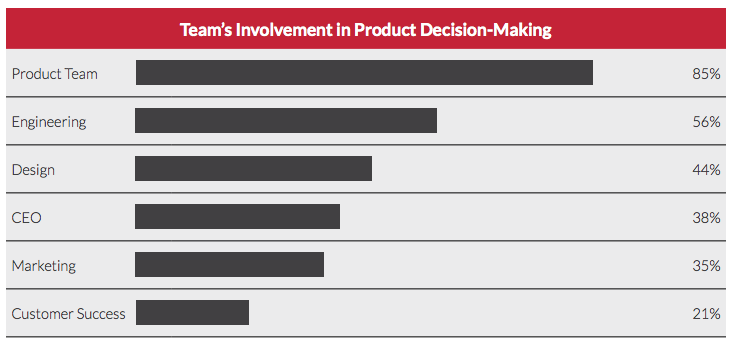How Effective Is Your Mobile Product Team?
This is a guest post by Ashley Sefferman of Apptentive
Today, there are over 50,000 apps added to the app stores each month, and a whopping two-thirds of all apps see fewer than 1,000 downloads over the course of their first year. To build a successful mobile product that can compete in an overcrowded marketplace, you have to have an effective team behind the wheel.
But how do you measure “effectiveness?” What does an effective team truly look like, and how does your current mobile product team compare?
It all starts with the team. To build an effective mobile product, you start by putting the customer at the center of the build to choose what goes in. Building an effective mobile product team should—and can—be approached in the same way. Today’s post offers methods to understand how effective your mobile product team currently is, and shares tips for how to improve.
Let’s dive in!
Who makes up a mobile product team?
Before we measure, we must first understand who makes up a mobile product team. In a recent survey of product managers, we asked respondents to name every internal team that has a say in their product decision-making to try to understand the importance of team cohesiveness. Not surprisingly, the Product team is the most heavily involved internal team in the product decision-making process, ranking 29% higher than any other team. Engineering (56%), Design (44%), the CEO (38%), Marketing (35%), and Customer Success (21%) all work with the product team to make decisions regarding the mobile product.

All said, that’s a lot of teams who need to weigh in. Team cohesiveness is key to any successful mobile product, and keeping everyone happy enough to work effectively on individual contributions and group work can be a daunting task if not approached correctly. When this many people are involved, happiness can be a strong indicator of predicting how quickly a product or update can be launched.
How does team health affect effectiveness?
It’s easy to only look at numbers when calculating success, but don’t forget to look at your team’s health to understand how your mobile product is performing. Whether one or five internal teams have touched a product, it’s important to gather data on everyone involved to understand how the internal machine is movin’ and groovin’, even it if it’s not exactly perfect science.

To gauge your starting point, start by asking yourself the following high-level questions:
- How effective are your team’s meetings? Are you able to accomplish specific tasks in meetings, or are they often susceptible to derailment? Unproductive meetings are one of the biggest professional time wasters, and often lead to unhappy employees who would rather be working on long to-do lists.
- Are teams held to the same standards? Effective team members rise to the standards that are set for them. Is there one team you expect more from than others? Is there one team always lagging behind? Expecting great things out of all of your internal teams is imperative to success, and it’s important to clear out biases in order to scale your product/feature launch process.
- Do the best ideas always get put on the table? Are team members empowered to share their ideas, or do they feel limited in what they can contribute? Silence undermines productivity, and the fewer ideas you discuss, the more stifled your progress will become.
The health of your team says a lot about how effective they can be. Once you have a baseline understanding of how “healthy” your mobile product employees and teams are, you can move on to collecting data around product launches and feature updates to better understand overall team effectiveness.
Metrics to measure
Mobile product teams have a plethora of metrics to choose from when it comes to determining the success of their products, so it can be difficult to understand which metrics are the most meaningful when it comes to measuring team effectiveness.
Just like you gather customer activity metrics (downloads, MAU, time in app, session length, etc.), you should regularly gather metrics to help gauge the success of your mobile product team. Start by calculating the following metrics to understand how well your mobile product team is doing:
1. Quality of features released. This metric helps you understand how the quality of your recently launched product and/or feature compares to the quality of previously launched products and/or features. Gauging quality isn’t a perfect science, but you know the standards set by your team better than anyone.
To calculate, dig deep into how you’ve rated features and products in the past, and compare those scores with your most recent release. For example, if you rate your feature releases on speed of adoption (i.e. how many customers use the update in the first day/week/month), every new feature release track this metric for comparison. How does your most recent feature stack up? Whether you measure releases in a binary way or through percentages, as long as you’re using the same method, you should be able to glean insights. The main use of this metric is to help you understand what you can improve for next time.
2. Timing of features released. This metric helps gauge release timing. It also helps you understand how “feature creep” affected your release so you can better assess what to change for next time.
To calculate, look at the deadlines and release dates you gave yourself for a feature update/product release/etc. How many deadlines were hit? For the deadlines that weren’t hit, how delayed were they? Take the number of deadlines hit on time and divide them by the total number of deadlines set for the project to give yourself a percentage score. Example: If three out of my five deadlines were hit on time, my team gets a 60% feature release score out of a possible 100%.
3. Team sentiment (i.e. “Team Love Score”). Similar to the Love Score you can calculate for your app, this metric takes many different components (including individual happiness, team progress, communication, individual involvement, etc.) into consideration. It’s the least scientific metric metric you can gauge your team’s success on as “sentiment” is quite interpreted; teams (and even individuals) define happiness in different ways, and what works for you may not always work for the next group.
To calculate, think about the “happiness” metrics that matter most to members of your team. Spend time with each team member and allow them to score themselves and the overall team on each metric, whether through survey, email, or in person. Once everyone weighs in, average the score for each category, then average your averages to come up with a final score.
Wrapping it up
A healthy team is an effective team, and although “effectiveness” means something different for every company, improving effectiveness can be approached in a relatively standard way. The more you focus on understanding team happiness, measuring the success of each new launch compared to past launches, and gauging overall team sentiment regularly, the more effective your mobile product team will become.
Have you seen success in measuring effectiveness in a different way? Leave your thoughts in the comments below!
Author bio: Ashley Sefferman is Head of Content at Apptentive, the best in-app communication software for app publishers. A mobile marketing and content strategy enthusiast, she writes about mobile apps, loyalty, inbound marketing, and making the mobile world a better place for people. Follow Ashley on Twitter @ashseff.
Thanks for
reading!
More articles you might be interested in:
Turning the Tables on 3 Mobile Product Management Myths
Your success as a product manager rests primarily on one thing and one thing only: a thorough understanding of your user. Sure, your position at the company requires you to act as a linchpin between all departments: development, marketing, sales,...
Read MoreGrowth Hacking for Mobile Product Managers
Mobile product management is taking the PM world by storm. As more companies make the transition to mobile, PMs everywhere are expanding their knowledge to encompass a new set of tools that can be applied directly to mobile products. Although...
Read More3 New Years Resolutions for Product and Team Improvement
2014 has been a great year here for us here at Apptimize. We’ve roll outed several key features (analytics integration, dynamic variables, and funnel metrics to name a few) and acquired new flagship customers that support our mission of bringing...
Read More